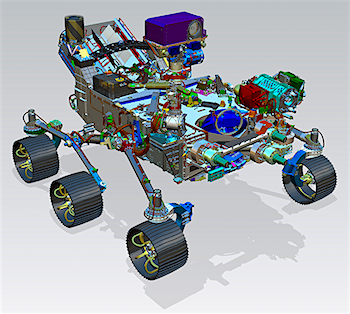 Ed. note: The following is an except from a story in Eos, published by the American Geophysical Union. Full story here.
Ed. note: The following is an except from a story in Eos, published by the American Geophysical Union. Full story here.
The next Mars rover will be able to land near rugged terrain, giving scientists access to diverse landscapes. It will also cache core samples, a first step in the quest to return samples to Earth.
NASA recently confirmed that it plans to fly to Mars in 2020, sending the fifth in a series of increasingly ambitious rovers to investigate the Red Planet. The specific landing site hasn’t been chosen yet, but the Mars 2020 mission will explore one of several possible paleoenvironments older than 3.5 billion years that might once have been conducive to microbial life.
The rover will assess the geology of the landing site and analyze surface targets for signs of ancient life using imaging, organic and inorganic geochemistry, and mineralogy. Notably, the rover, also called Mars 2020, will also be the first to select, collect, and cache a suite of samples from another planet for possible future return to Earth, fulfilling the vision of the most recent planetary science decadal survey to take the first step toward Mars Sample Return [National Research Council, 2011]. (…)
The rover’s scientific instruments will observe the surrounding terrain and provide the critical context for choosing where samples will be collected.
Previous rovers used sophisticated analytic instruments and prepared rock and soil specimens for analysis on board the rover itself. Mars 2020, however, will be the first rover tasked with detailed exploration of the surface to support the collection of a large, high-value sample suite designated for possible later study in laboratories back on Earth. [More at link]








